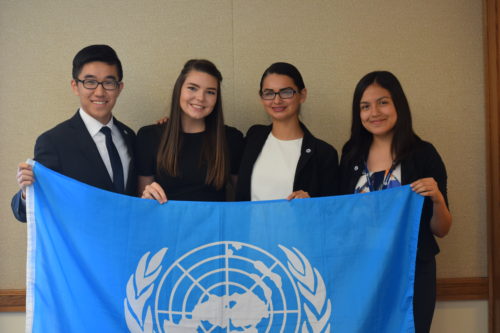
Your child is doing Model United Nations! But what exactly are they doing when they dress up in Western Business Attire and head off to a Model UN conference for a weekend? And how does it change as they go from being a novice to a more experienced MUNer?
Although there’s no formal levels in Model UN, the Model UN circuit could be informally divided into six levels of experiences. These levels are actually what are reflected in the programs of the Model United Nations Institute. Here are the 6 Levels of Model UN explained to parents:
Level 1: Middle School
Yes, Model UN is available at the middle school level! In fact, it’s actually available at the upper elementary school level, though it’s far less common. Nowadays there are an increasing number of middle school Model UN conferences worldwide. Middle school students are introduced to global issues for the first time and typically debate topics where research is easier to find — but not necessarily easier to solve — such as Child Soldiers and Equal Representation of Women. They tend to be high energy and actively build alliances to solve these issues. Middle school students can start at the Junior Diplomat program, and advanced middle school students can learn at the Junior Ambassador program.
Level 2: High School Novice
The vast majority of Model UN students start as high school freshmen and ideally attend novice conferences. These are usually 1-day local conferences where students are expected to be on country policy — whether they’re assigned Canada, China, or Cameroon — and use formal Rules of Procedure when debating about global topics such as Climate Change and Nuclear Non-Proliferation. High school novices are challenged to make both prepared speeches and impromptu speeches to persuade the room to vote for their solutions. High school novices can learn how to do Model UN by reading the Diplomat Guide or attending the Diplomat program.

Level 3: High School Advanced
Once students understand the basics of Model UN, they go on to participate in Advanced Model UN conferences. These are usually 2-4 day conferences, and many of the largest and most prestigious conferences host over 3,000 delegates at once! At this level, Model UN can become a competition as students are judged for awards as they debate specialized topics such as economic development in Africa or global hot spots such as Syria. Social dynamics — ability to persuasively build allies and diplomatically negotiate with adversaries — become much more important (as it is in real life diplomacy). Advanced high school students can take their skills to the next level by reading the Ambassador Guide or polishing their skills at the Ambassador program.
Level 4: High School Crisis
Crisis simulations are common at the college level, and now it is becoming increasingly available and popular at the high school level. Crisis simulations are when students represent Cabinet members and have to respond to crises that are thrown at them! For example, students could be simulating the US Cabinet and a terrorist attack goes off in Washington DC! What should they do next? That depends on the role they are assigned to play — the Secretary of State and Secretary of Defense would react differently! Crisis committees are more complex than Advanced committees because they heavily emphasize impromptu speaking, rapid decision-making, and creative problem-solving instead of prepared speeches and research. Students can experience this at the Crisis program or pick up the Crisis guide to get started.
Level 5: High School Student Officers
By the time a high school Model UN student is an upperclassman, he or she may have stepped into a student officer role in the Model UN club. This could include serving as President running the club, as the Head Delegate (team captain) training the team, as Secretary-General running the club’s own conference or mock session, or in other impactful leadership roles. They’re often busy after-school helping take their club to the next level. Students officers work closely with the Faculty Advisor and stand out — this is how advisors can write richer details into the students’ college letters of recommendations. Leaders ready to become student officers can learn the best practices at the Secretary-General program.
Level 6: College
Model UN continues in college! College students compete in a tight-knit national (or even international) circuit of Model UN conferences featuring some of the brightest future lawyers, diplomats, politicians, government officials, businesspeople, teachers, academics, and change-makers in the world. They build a strong professional network and strong professional skill set by going to all these conferences. Many college Model UN students also give back by serving as Chairpersons (judges) for high school conferences. And some even go on to teach Model UN professionally, including serving as Diplomacy Fellows at the Model UN Institute or becoming teachers and Faculty Advisors for Model UN clubs!

